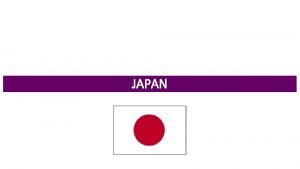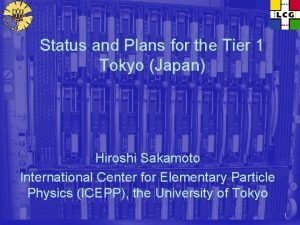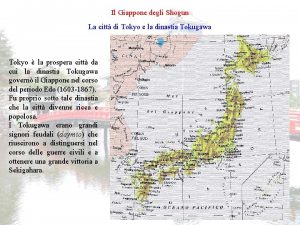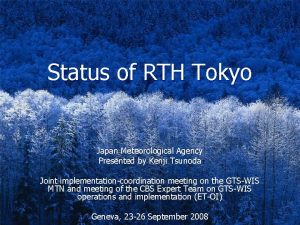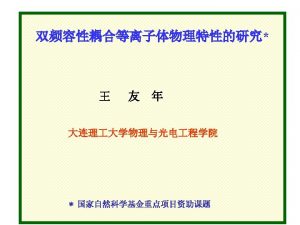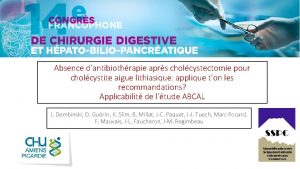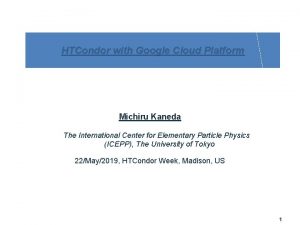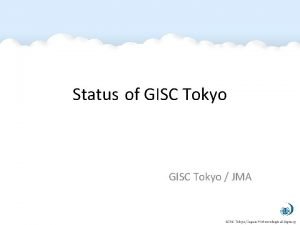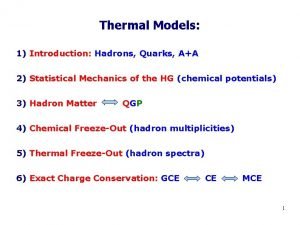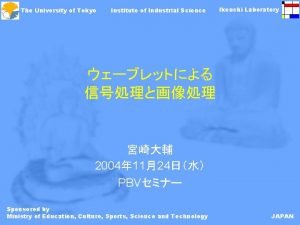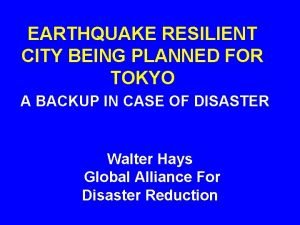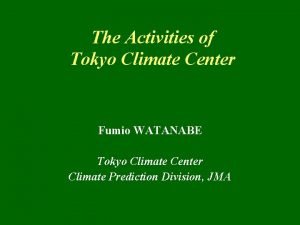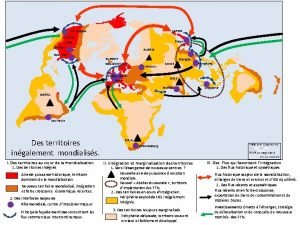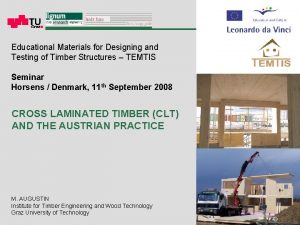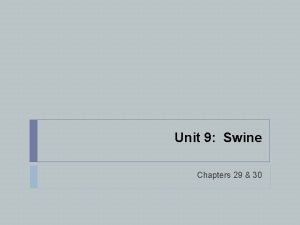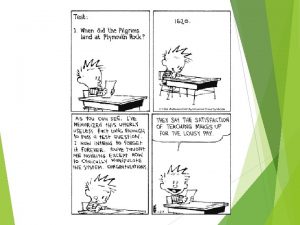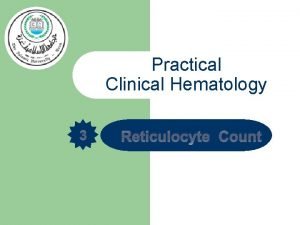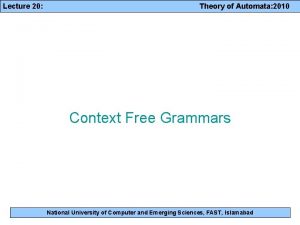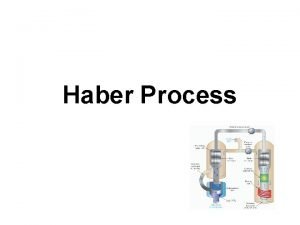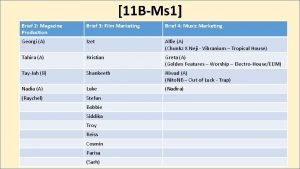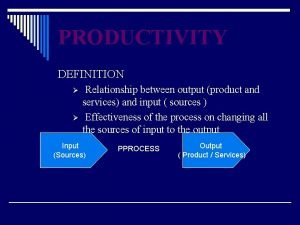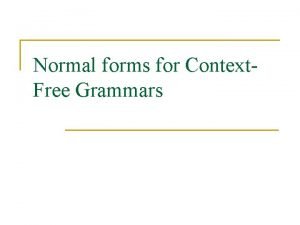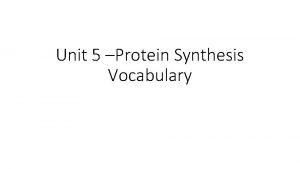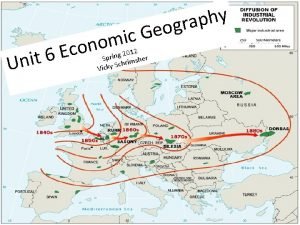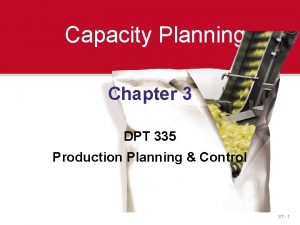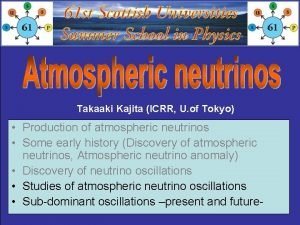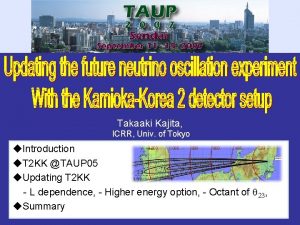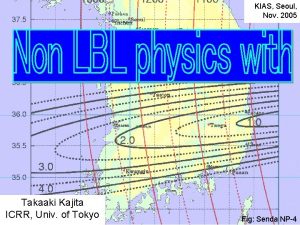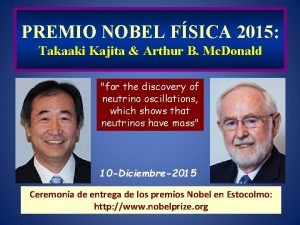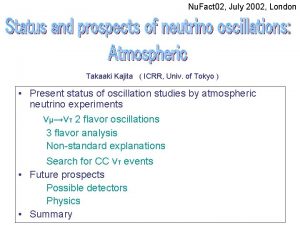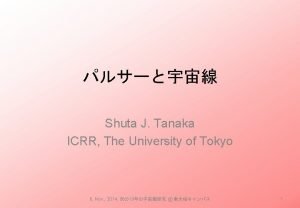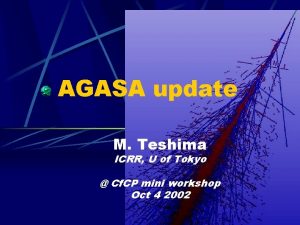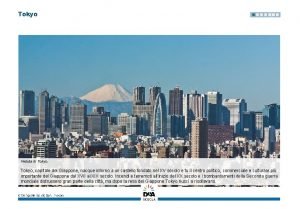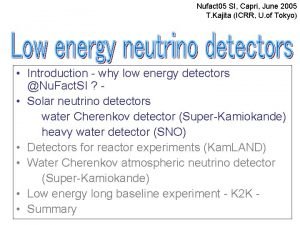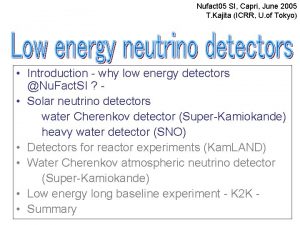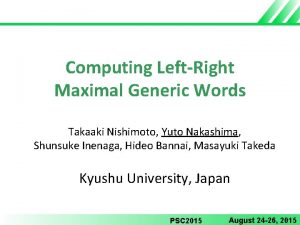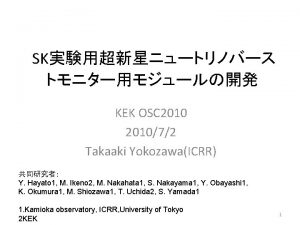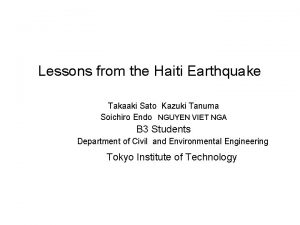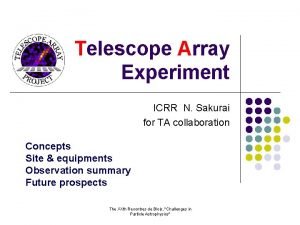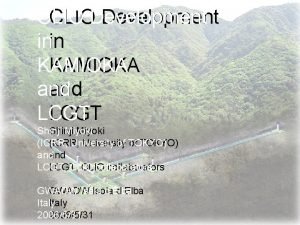Takaaki Kajita ICRR U of Tokyo Production of


























































- Slides: 58

Takaaki Kajita (ICRR, U. of Tokyo) • Production of atmospheric neutrinos • Some early history (Discovery of atmospheric neutrinos, Atmospheric neutrino anomaly) • Discovery of neutrino oscillations • Studies of atmospheric neutrino oscillations • Sub-dominant oscillations –present and future-

Atmosphere


Calculating the atmospheric neutrino beam Measured cosmic ray proton flux + geomagnetic field Total nm+nm flux + decay of p or K + …… Flux × En 2 + (p+Nucleon) int. En(Ge. V)

Some features of the beam (1) (nm+ nm)/(ne+ ne) nm/ne ratio is calculated to an accuracy of better than 3% below ~ 5 Ge. V.

Some features of the beam (2) @Kamioka (Japan) Zenith angle Up-going Down cosqzenith Up/down ratio very close to 1. 0 and accurately calculated (1% or better) above a few Ge. V.

Comment: Geomagnetic field and the flux Assume a detector in Kamioka (Japan) Up-going Ge. V/c Down-going Calculate the minimum momentum of a cosmic ray proton directing to Kamioka arriving at the atmosphere. For this location, flux(up) > flux(down) in the low-energy range

Comment: Flux in the horizontal direction now 3 D calculation 10 years ago… 1 D calculation

Horizontal enhancement C. R. (3 D) ν C. R. (1 D) Target area(1 D, 3 D) G. Battistoni et al. , Astropart. Phys. 12, 315 (2000) 1 D 3 D

How accurate is the absolute normalization of the flux ? Syst error better than 5% Below 10 Ge. V, the flux is predicted to better than 10%. Above 10 Ge. V the flux calculation must be improved. (This statement is for Honda 04 flux. )

Neutrino interactions Quasi-elastic CC total Deep inelastic 1 p production Eν(Ge. V) Quasi-elastic n 1 p production n lepton Deep inelastic lepton n p N N’ N N* N’ N lepton p p N’

Event classification Fully Contained (FC) (E ~1 Ge. V) Partially Contained (PC) (E ~10 Ge. V) Stopping (E ~10 Ge. V) Through-going (E ~100 Ge. V)

Comment: upward-going muons s(n. N) ∝En Range ∝Em, <Em> ∝En Wide energy range


Discovery of atmospheric neutrinos At the depth of 3200 meters (8800 meters water equivalent) in South Africa First observed on Feb. 23, 1965 By F. Reines et al. At the depth of 2400 meters (7500 meters water equivalent) in India (Kolar Gold Field) First published on Aug. 15, 1965 By C. V. Achar et al. photo of the South Africa experiment (nm. N m. X) Detector for the KGF experiment

Zenith angle distribution (updated data from the South Africa experiment) PRD 18, 2239 (1978) Cosmic ray muons Neutrino induced muons Vertical (going up or down) Horizontal going


The first hint ? (South Africa experiment, 1978) Cosmic ray muons PRD 18, 2239 (1978) Neutrino induced muons Vertical Horizontal Deficit of muon data “We conclude that there is fair agreement between the total observed and expected neutrino induced muon flux …”

Proton decay experiments Grand Unified Theories tp=1030± 2 years Kamiokande (1000 ton) IMB (3300 ton) NUSEX (130 ton) Frejus (700 ton) These experiments observed many contained atmospheric neutrino events (background for proton decay).

Selection of atmospheric neutrinos Example: Kamiokande At 1000 m underground, cosmic ray m: 0. 3/sec/detector Atmospheric n: 0. 3/day/1000 ton n 2. 7 m 3. 5 m Fiducial region m anticounter

Detecting Cherenkov photons Number of Ch. photons with λ=300600 nm emitted by a relativistic particle per cm = 340. Need an efficient detection of the photons. Large PMTs Charged particle Photomultiplier tube (PMT) ν 20 cm φ n (refractive index)=1. 34 in water θ=42 deg. for β=1 50 cm φ (Super-K)

Detecting Cherenkov photons and event reconstruction Super-K Charged particle PMT n Time: vertex position direction Pulse height (number of pe’s): energy Color: timing Size: pulse height

Kamiokande: J. Phys. Soc. Jpn 55, 711 (1986) ckground papers: Too few muon decays

On the other hand, … several “no evidence” for atmospheric neutrino oscillation papers Boiliev et al, (Baksan), Sov J. Nucl. Phys. 34, 787 (1981) J. M. Lo. Secco et al. (IMB), PRL 54, 2299 (1985) R. M. Bionta et al. , (IMB), PRD 38, 768 (1988)

m/e ratio measurement in electronics Kamiokande Water system 1983 (Kamiokande construction)

Electrons and muons Kamiokande electron-like events muon-like events Super-K

Particle identification electron-like event muonlike event e: electromagnetic shower, multiple Coulomb scattering m: propagate almost straightly, loose energy by ionization loss Difference in the event pattern Particle ID

Particle ID performance (figures from Super-K) Cosmic ray μ ε=99%@Super-K (98% @Kamiokande) e from μ decay

First result on the m/e ratio (1988) Data MC prediction e-like ( ~CC ne) 93 88. 5 m-like ( ~CC nm) 85 144. 0 “We are unable to explain the data as the result of systematic detector effects or uncertainties in the Kamiokande atmospheric neutrino fluxes. Some (3000 ton Water Ch. as-yet-unaccoundted-for physics ~ 1000 ton fid. Vol. ) such as neutrino oscillations might explain the data. ” 2. 87 kton・year K. Hirata et al (Kamiokande) Phys. Lett. B 205 (1988) 416.

However, … Let’s write the atmospheric nm deficit by (m/e)data/(m/e)MC

First supporting evidence for small m/e IMB experiment also observed smaller (m/e) in 1991 and 1992.

However, … Let’s write the atmospheric nm deficit by (m/e)data/(m/e)MC

Cosmic ray p, He, …… Detector nm nt Detect down-going and up-going n Atmospheric neutrinos and neutrino oscillations oscillation Cosmic ray p, He, …… Down-going Atmosphere Up-going

Zenith angle distributions Kamiokande (Evis <1. 3 Ge. V) IMB (<1. 5 Ge. V) Consistent with no zenith angle dependence. . .

Angular correlation n (CC ne samples) lepton Nucleon (MN= 1 Ge. V/c 2) q (CC nm sample) Lepton momentum (Me. V/c)

Next: zenith angle…(Kamiokande, 1994) multi-Ge. V m-like events No oscillation nm nt Dm 2=1. 6・ 10 -2 e. V 2 Up-going Down-going Deficit of upward-going m-like events +0. 13 Up/Down=0. 58 -0. 11 (2. 9 σ)


Super-Kamiokade detector 50, 000 ton water Cherenkov detector (22, 500 ton fiducial volume) 42m Exit 11200 PMT(Inner detector) 1900 PMT(Outer detector) 39m 1000m underground

Around Super-K Entrance to the mine

Super-Kamiokande (under construction, Dec. 1994)

Super-Kamiokande detector under construction Early summer 1995

Water filling in Super-Kamiokande Jan. 1996

Event type and neutrino energy Fully Contained (FC) Partially Contained (PC) Stopping Through-going

Various types of atmospheric neutrino events (1) FC (fully contained) n Single Cherenkov ring electron-like event Color: timing Size: pulse height ・Both CC ne and nm (+NC) ・Need particle identification to separate ne and nm Single Cherenkov ring muonlike event Outer detector (no signal)

Various types of atmospheric neutrino events (2) PC (partially contained) n ・ 97% CC nm Signal in the outer detector

Various types of atmospheric neutrino events (3) Upward going muon ・ almost pure CC nm ν Upward stopping muon Upward throughgoing muon

Cosmic ray p, He, …… Detector nm nt Detect down-going and up-going n Atmospheric neutrinos and neutrino oscillations oscillation Cosmic ray p, He, …… Down-going Atmosphere Up-going

Super-Kamiokande @Neutrino 98 Fully contained, 1 -ring events with Evis > 1. 33 Ge. V plus partially contained events SK concluded that the observed zenith angle dependent deficit (and the other supporting data) gave evidence for neutrino oscillations.

Super-Kamiokande data now @Neutrino 98 (535 day) Now (2293 day) No oscillation t oscillation Up-going Down-going

Results from the other atmospheric neutrino experiments MACRO Soudan-2 MINOS (first data in 2005)

Soudan 2 nm CC quasi -elastic ne CC nm CC deep inelastic

Soudan 2 • • 5. 9 kton・yr exposure Partially contained events included. L/E analysis with the “high resolution” sample Upward stopping muons included. hep-ex/0507068 Zenith angle e Upgoing μ Downgoing Upward stopping muons Phys. Rev. D 68 (2003) 113004 Reconstructed Lν/ Eν dist. e μ No osc. nm nt osc.

MACRO Upward throughgoing m Upwardgoing PC Upward throughgoing m Upward stopping m + down-going PC Down-going cosmic ray m

MACRO PLB 566 (2003) 35 EPJ C 36(2004)323 No osc. Osc. or No osc. Oscillation Δm 2 =2. 5× 10 -3 Upward horizontal

MINOS PRD 73, 072002 (2006) 6. 18 kton・yr (418 days) nm zenithangle L/E Separation of nm and anti-nm

nm nt oscillation parameters nm nt MINOS (atmospheric) 90%CL Soudan-2 MACRO Super-K Also, consistent results from long baseline experiments (K 2 K & MINOS) D. Harris’s lecture

Summary of Atmospheric Neutrino-1 • Experimental studies of atmospheric neutrinos started in the mid. 1960’s. • Different type of atmospheric neutrino experiments started in the 1980’s (proton decay experiments). • Study of the background for proton decay found unexpected atmospheric nm deficit. • In 1998, the nm deficit was concluded as evidence for neutrino oscillations.

End
 Memasarkan produk multimedia termasuk dalam proses produksi
Memasarkan produk multimedia termasuk dalam proses produksi Japan capital
Japan capital Sinet plans
Sinet plans Tokyo shogun
Tokyo shogun Tokyo meteorological agency
Tokyo meteorological agency Quartier tokyo
Quartier tokyo Ccp 1
Ccp 1 Angiocholite tokyo 2018
Angiocholite tokyo 2018 Greater tokyo population
Greater tokyo population The tokyo are on
The tokyo are on [email protected]
[email protected] Gisc tokyo
Gisc tokyo Tokyo gce
Tokyo gce Climograph
Climograph Institute of industrial science the university of tokyo
Institute of industrial science the university of tokyo Meditouch otolaryngology
Meditouch otolaryngology Tokyo disneyland earthquake
Tokyo disneyland earthquake Slidetodoc.com
Slidetodoc.com Northern island in japan
Northern island in japan Doc football academy
Doc football academy Mega-ix
Mega-ix Tokyo climate center
Tokyo climate center Pecha kucha vorlage
Pecha kucha vorlage Tokyo chicago
Tokyo chicago Sputonik
Sputonik Clt production process
Clt production process Chaîne de production textile
Chaîne de production textile Introduction to production management
Introduction to production management End of meiosis 2
End of meiosis 2 Système porte schéma
Système porte schéma Single camera production
Single camera production Film production roles
Film production roles Objectives of swine production
Objectives of swine production Four factors of production
Four factors of production Spectre production companies
Spectre production companies Nfs reticulocytes
Nfs reticulocytes Management deals with
Management deals with Production planning and inventory control
Production planning and inventory control Useless production in automata
Useless production in automata Shop floor control
Shop floor control Nature of production management
Nature of production management Global production outsourcing and logistics
Global production outsourcing and logistics Garrett's model of speech production
Garrett's model of speech production Film production
Film production Haber bosch process flow diagram
Haber bosch process flow diagram Where are goods produced
Where are goods produced Production brief
Production brief K12 system
K12 system Apache tomcat
Apache tomcat Production and productivity definition
Production and productivity definition Factors affecting facility layout
Factors affecting facility layout Who puts together land , labour and capital for production
Who puts together land , labour and capital for production Normal forms for context free grammar
Normal forms for context free grammar Building vocabulary: protein production
Building vocabulary: protein production Slope of budget line or price line is
Slope of budget line or price line is Capital deepening examples
Capital deepening examples Blue banana
Blue banana Bakery production planning
Bakery production planning In-line egg production
In-line egg production

